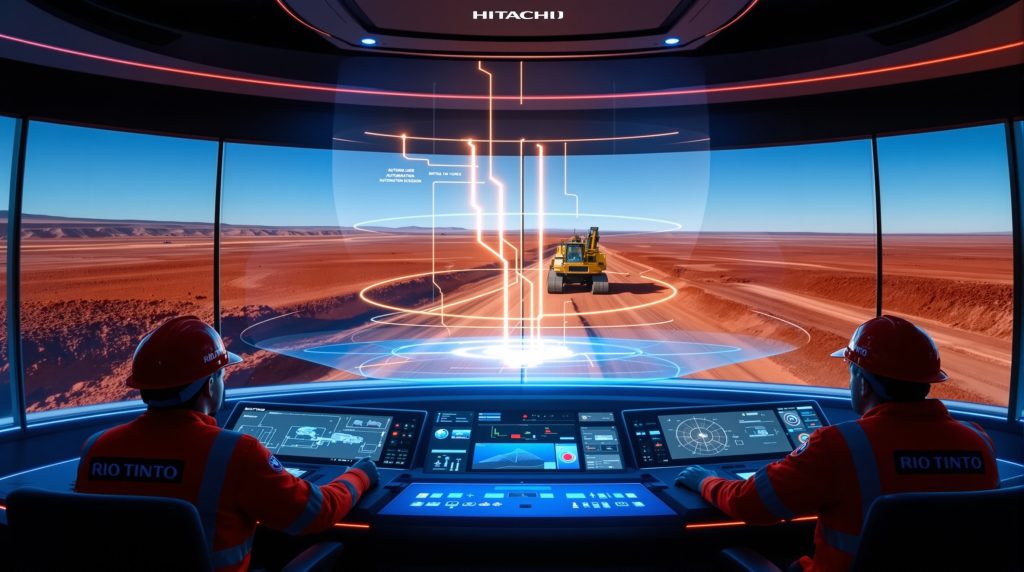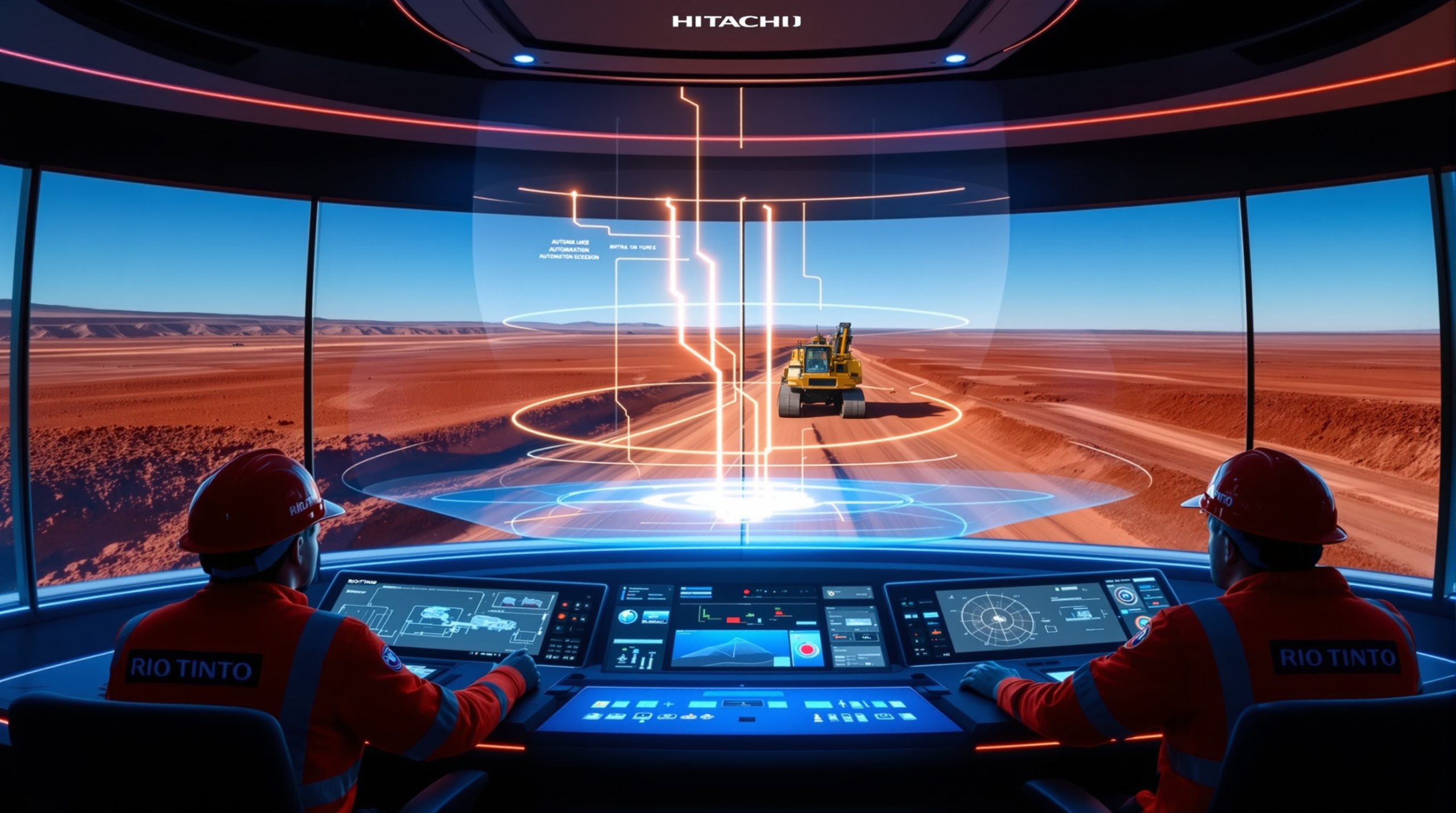Revolutionizing Mining Operations: How Hitachi and Rio Tinto's Collaboration is Advancing Remote Technology
Technological innovation in mining operations has taken a significant leap forward with a groundbreaking partnership between industrial giants Hitachi Construction Machinery and Rio Tinto. This strategic alliance, focused on developing cutting-edge remote operation technologies for ultra-large hydraulic excavators, promises to transform how mining companies approach safety, efficiency, and productivity in their operations.
The Strategic Partnership: Combining Expertise for Innovation
The formal charter agreement between Hitachi Construction Machinery and Rio Tinto's subsidiary Technological Resources was established in October 2025. This collaboration strategically combines Hitachi's technical expertise in machinery development with Rio Tinto's extensive operational experience in mining environments.
Hiroshi Kanezawa, Vice-President of Mining Business Unit and Executive Officer at Hitachi Construction Machinery, emphasized the significance of this partnership: "Since entering the mining machinery business in the late 1970s, Hitachi Construction Machinery Group has driven technology innovation for ultra-large hydraulic excavators. Our open collaboration with Rio Tinto will accelerate the development of highly versatile autonomous operation technologies for the benefit of the whole mining industry."
The partnership centers around Hitachi's newly introduced "LANDCROS" concept, which stands for Customer, Reliable, Open, and Solutions—representing reliable and open solutions designed specifically for mining customers. This customer-centric approach signals a departure from traditional closed systems, moving toward more adaptable and integrated mining technologies.
Next-Generation Mining Technologies Under Development
The collaboration focuses on three key technological areas that represent the cutting edge of mining equipment innovation:
Operator-Assist Technologies
These advanced systems enhance operator performance through intelligent controls and real-time guidance. Key developments include:
- Smart systems that analyze terrain and material characteristics to optimize excavation
- Fatigue-monitoring technology that helps maintain consistent performance throughout shifts
- Precision control systems that improve bucket loading efficiency by up to 15%
- Intelligent feedback mechanisms that help operators develop better techniques
These operator-assist technologies serve as the foundation for more advanced autonomous features, providing immediate productivity benefits while preparing the groundwork for future innovations in AI in Mining Operations.
Remote Operation Systems
Remote operation represents a fundamental shift in how mining equipment is controlled. Key components include:
- High-definition, multi-angle camera systems that provide operators with comprehensive visibility
- Low-latency control interfaces that minimize response delays between operator actions and machine movements
- Environmental sensors that detect ground conditions, material density, and potential hazards
- Secure, redundant communication networks ensuring uninterrupted connection between operators and equipment
Remote operation capabilities allow skilled operators to work from comfortable control centers rather than in harsh mining environments, simultaneously improving working conditions and operational capabilities.
Partial Autonomy Features
The most advanced technologies under development involve partial autonomy, where excavators can perform repetitive tasks with minimal human intervention:
- Self-positioning systems that automatically optimize the excavator's location relative to loading targets
- Automated digging cycles that maintain consistent bucket fill rates across varying material conditions
- Obstacle detection and avoidance systems that prevent collisions and equipment damage
- Machine learning algorithms that continuously improve performance based on operational data
This partial autonomy approach balances the benefits of automation with the flexibility of human oversight, representing a practical middle ground between fully manual and completely autonomous operations.
Transforming Mining Operations Through Technology
The technologies being developed through this collaboration will fundamentally change how mining operations function, with impacts across multiple operational dimensions:
Enhanced Safety Protocols
Safety remains a primary concern in mining environments, and remote technology directly addresses several key risks:
- Operators can be completely removed from hazardous mining faces and unstable terrain
- Exposure to dust, noise, and vibration is significantly reduced through remote operation
- Consistent performance algorithms prevent the safety risks associated with operator fatigue
- Automated hazard detection systems can identify potential dangers before they become critical
Industry statistics indicate that removing operators from the immediate mining environment can reduce accident rates by up to 40%, making this technology a game-changer for mining safety.
Productivity Improvements
Beyond safety, these technologies promise substantial productivity benefits:
- 24/7 operations become more feasible with less operator fatigue and shift-change efficiency
- Consistent performance across shifts eliminates productivity variations between different operators
- Optimized digging and loading cycles can improve material movement efficiency by 20-30%
- Equipment maintenance requirements may decrease with more precise and consistent operation
These productivity improvements directly impact the bottom line, potentially transforming the economics of mining operations, particularly in remote or challenging locations where data‑driven operations are increasingly important.
Operational Flexibility
The flexibility provided by remote and autonomous systems creates new operational possibilities:
- Mining can continue during weather conditions that would normally halt operations
- A single remote operations center can support multiple sites across different geographic regions
- Skilled operator expertise can be applied across multiple machines and sites
- Operations in extremely remote locations become more economically viable
This flexibility represents a significant competitive advantage for mining companies facing increasing pressure to access more challenging deposits while maintaining cost efficiency.
Implementation Timeline and Testing Approach
The collaboration follows a structured development roadmap with clear phases and goals:
Initial Development Phase (2025-2027)
The first phase focuses on foundational technology development:
- Laboratory testing of control systems and interfaces to establish baseline performance
- Simulation modeling to predict operational outcomes across various scenarios
- Small-scale field tests in controlled environments to validate core technologies
- Initial operator training and feedback collection to refine user interfaces
This phase establishes the technical feasibility of the systems before larger-scale deployment.
Field Testing and Deployment (2027-2029)
The second phase moves into real-world implementation:
- Deployment of prototype systems at Rio Tinto's Pilbara operations
- Comprehensive data collection across various operational conditions
- Side-by-side comparison with conventional operations to measure improvements
- Iterative refinement based on operational feedback and performance metrics
This extended field testing ensures the technologies perform reliably under actual mining conditions before full-scale adoption.
Platform Expansion (2030 and beyond)
The long-term vision extends beyond the initial implementation:
- Development of a standardized platform supporting multiple equipment types
- Integration with broader mine management and automation systems
- Potential application to additional mining equipment beyond excavators
- Creation of fully integrated autonomous mining ecosystems
By 2030, Hitachi aims to create a comprehensive platform capable of operating several excavators with partial autonomy across various mining locations, representing a significant evolution in mining industry evolution.
The Pilbara Testing Environment: Ideal Conditions for Innovation
Rio Tinto's mining operations in Western Australia's Pilbara region provide an exceptional environment for testing these advanced technologies:
Environmental Advantages
The Pilbara offers challenging but controlled testing conditions:
- Vast open-pit operations with varied terrain and material characteristics
- Remote location that benefits significantly from automation technologies
- Extreme climate conditions that test equipment durability and reliability
- Established infrastructure supporting technological innovation and deployment
These environmental factors ensure technologies developed will be robust enough for global deployment in various mining conditions.
Operational Benefits
The existing operations provide significant advantages for technology testing:
- Experienced operators who can provide expert feedback on system performance
- Established baseline performance metrics for comparative assessment
- Existing autonomous haulage systems providing integration opportunities
- Continuous operations allowing for extensive data collection across all conditions
This real-world operational environment ensures the technologies developed are not just technically sound but practically valuable in commercial mining applications.
Feedback Mechanisms
The testing program incorporates comprehensive feedback systems:
- Structured evaluation protocols measuring both technical performance and operator acceptance
- Regular performance reviews identifying improvement opportunities
- Direct operator input for interface and control refinements
- Continuous monitoring of safety, productivity, and equipment health metrics
This feedback-driven approach ensures the technologies evolve to meet actual operational needs rather than just theoretical specifications.
Broader Industry Implications
This collaboration between Hitachi and Rio Tinto has implications far beyond their immediate business interests:
Setting New Industry Standards
The partnership is likely to establish benchmarks that influence the entire mining sector:
- Safety protocols for remote and autonomous mining operations
- Interoperability standards for mining equipment automation
- Operator training requirements for advanced technology systems
- Performance metrics for evaluating mining automation solutions
These standards could shape regulatory approaches and industry practices globally as mining automation becomes more prevalent.
Technological Advancement Acceleration
The collaboration represents a significant acceleration in mining technology development:
- Demonstrating viable applications of autonomous systems in complex mining environments
- Creating proven technological pathways for further innovation
- Establishing practical limits of what can be automated in mining operations
- Providing real-world validation of theoretical automation concepts
This acceleration could compress the typical decade-long technology adoption cycle in mining to just a few years.
Workforce Evolution
Perhaps most significantly, these technologies will transform the mining workforce:
- Creating new roles focused on remote operation and autonomous system management
- Shifting skill requirements from physical capability to technological proficiency
- Developing training programs for the next generation of mining professionals
- Potentially enabling more diverse participation in mining operations
This workforce evolution represents both a challenge and an opportunity for mining companies and educational institutions preparing workers for future roles.
Building on Previous Collaboration Success
The current initiative builds upon earlier successful collaborations between Hitachi and Rio Tinto, creating a foundation of trust and proven results:
Previous Joint Initiatives
Earlier collaborative projects established the working relationship:
- Verification testing of excavator component durability in harsh mining conditions
- Early-stage development and evaluation of operator-assist technologies
- Establishment of performance benchmarks for mining equipment in Pilbara operations
- Data sharing protocols that protect proprietary information while enabling innovation
These previous successes provided the confidence to pursue more ambitious technological goals.
Evolutionary Advancement
The current collaboration represents a significant evolution from earlier work:
- Progression from basic operator assistance to partial autonomy
- Expansion from single-machine focus to integrated equipment platforms
- Transition from operational support to fundamentally transformative technologies
- Development of more comprehensive data collection and analysis capabilities
This evolutionary approach builds upon proven foundations rather than attempting revolutionary changes without sufficient experience.
Addressing Key Technological Challenges
Despite the promising potential, significant challenges must be overcome for successful implementation:
Technical Hurdles
Several technical challenges remain to be solved:
- Ensuring reliable connectivity in remote mining locations with limited infrastructure
- Developing sensor systems capable of operating in dusty, vibration-heavy environments
- Creating control interfaces that maintain operator situational awareness despite physical distance
- Balancing automation with the need for human judgment in complex situations
Overcoming these technical challenges requires innovative solutions that may have applications beyond mining.
Operational Challenges
Beyond technical issues, operational integration presents its own difficulties:
- Maintaining productivity during technology transition periods
- Integrating new systems with existing fleet management and dispatch platforms
- Developing appropriate maintenance protocols for technology-intensive equipment
- Managing change resistance among traditional mining personnel
Addressing these operational challenges requires careful change management and phased implementation approaches.
Implementation Considerations
Practical implementation factors must also be considered:
- Training requirements for both operators and maintenance personnel
- Regulatory compliance in jurisdictions with varying approaches to autonomous systems
- Data management and cybersecurity for connected mining equipment
- Business case development justifying the significant investment required
These implementation considerations are often as challenging as the technological development itself.
Alignment with Mining Industry Trends
This collaboration aligns perfectly with broader industry directions:
Industry Direction Alignment
The mining sector is increasingly embracing technological transformation:
- Growing focus on automation across all aspects of mining operations
- Increasing emphasis on worker safety and remote operation capabilities
- Industry-wide push for improved operational efficiency and productivity
- Rising importance of data-driven decision making and predictive analytics
This alignment with industry trends suggests the technologies developed will find ready acceptance in the broader market.
Competitive Positioning
Early adopters of these technologies may gain significant competitive advantages:
- Operational efficiency improvements that reduce per-ton extraction costs
- Enhanced ability to operate in challenging or remote environments
- Attraction and retention of technology-savvy mining professionals
- Improved safety records and regulatory compliance
These competitive advantages could reshape market dynamics, particularly as resource extraction becomes more challenging globally.
Sustainability Implications
The technologies also align with increasing sustainability pressures on mining operations:
- More precise extraction with less environmental disturbance
- Reduced energy consumption through optimized equipment operation
- Lower emissions from more efficient operational patterns
- Decreased infrastructure requirements at remote sites
These sustainability benefits represent an important secondary advantage beyond the primary operational improvements, supporting the broader sustainable mining transformation occurring across the industry.
Expected Outcomes and Future Potential
Looking ahead, this collaboration promises significant near-term benefits while setting the stage for more transformative long-term changes:
Near-Term Benefits
Initial implementations will deliver valuable operational improvements:
- Measurable safety improvements through reduced operator exposure to hazards
- Productivity gains of 15-25% in excavation operations
- Decreased unplanned downtime through more consistent equipment operation
- Enhanced operator working conditions and job satisfaction
These near-term benefits will help justify the substantial investment required for implementation.
Medium-Term Developments
As the technologies mature, broader operational changes will emerge:
- Establishment of centralized remote operation centers managing multiple sites
- Integration of excavator automation with autonomous haulage systems
- Development of standardized protocols for semi-autonomous mining operations
- Creation of comprehensive digital twins for mining operations
These medium-term developments will fundamentally change operating models for advanced mining companies.
Long-Term Vision
The ultimate potential extends to comprehensive transformation of mining operations:
- Creation of fully integrated autonomous mining ecosystems
- Possibility of unmanned operations in hazardous or extremely remote environments
- Transformation of mining from a primarily physical industry to a technology-driven one
- Development of new business models based on mining-as-a-service concepts
This long-term vision represents a fundamental reimagining of mining operations for the 21st century, affecting everything from operational strategies to modern mine planning approaches.
FAQ: Remote Mining Technology Collaboration
How does remote operation technology improve mining safety?
Remote operation technology removes operators from the immediate dangers of mining environments—including rockfalls, slope failures, dust exposure, and extreme weather conditions. By controlling equipment from secure remote centers, operators maintain full operational capability while eliminating physical risk exposure. This approach has been shown to reduce mining-related injuries by up to 40% in operations where it has been implemented.
What is meant by "partial autonomy" in mining excavators?
Partial autonomy represents a middle ground between fully manual and completely autonomous operation. With partial autonomy, operators establish initial parameters and positioning, after which the excavator can automatically repeat digging and loading cycles with minimal intervention. The system handles repetitive tasks while operators maintain oversight and intervene when conditions change or unexpected situations arise. This approach maximizes the benefits of automation while maintaining human judgment for complex decisions.
How will this technology affect mining jobs?
Rather than eliminating mining jobs, these technologies will transform them. While fewer operators may work directly at mining faces, new roles will emerge in remote operation centers, system maintenance, data analysis, and autonomous system supervision. The skill profile will shift from primarily physical capabilities to technical expertise, creating opportunities for workforce development and diversity. The overall number of jobs may remain relatively stable while their nature evolves significantly.
What makes the Pilbara region ideal for testing this technology?
Rio Tinto's Pilbara operations offer an ideal testing environment because they combine large-scale mining activities with remote locations and challenging conditions—precisely where remote and autonomous technologies provide maximum benefit. Additionally, Rio Tinto has already implemented autonomous haulage systems in the region, providing integration opportunities and experienced personnel familiar with advanced mining technologies. The extensive operational data available from these established mines also enables accurate before-and-after performance comparisons.
How does this initiative compare to autonomous truck systems already in use?
While autonomous haulage trucks have become increasingly common in mining operations, excavators present unique challenges due to the complex, variable nature of digging operations. Trucks follow relatively predictable paths and perform consistent tasks, while excavators must adapt to changing material conditions, optimize bucket filling, and make continuous adjustments. This initiative addresses these more complex challenges, potentially completing the automation ecosystem in mining operations and enabling end-to-end autonomous material movement from extraction to processing.
Conclusion: A New Era in Mining Technology
The collaboration between Hitachi Construction Machinery and Rio Tinto represents much more than a typical business partnership—it signals the beginning of a new era in mining technology. By combining Hitachi's equipment expertise with Rio Tinto's operational experience, the companies are poised to develop solutions that address the mining industry's most pressing challenges: safety, productivity, and operational flexibility.
As these technologies move from development through testing and into widespread deployment, they will transform not just how mining equipment operates, but how mining companies structure their operations, develop their workforce, and compete in an increasingly challenging global market. The innovations emerging from this partnership may well define mining operations for decades to come, creating safer, more efficient, and more sustainable resource extraction worldwide.
Want to Profit from the Next Major ASX Mineral Discovery?
Don't miss out on potential mining investment opportunities—Discovery Alert's proprietary Discovery IQ model provides real-time notifications on significant ASX mineral discoveries, empowering subscribers to identify actionable opportunities before the broader market. Begin your 30-day free trial today at Discovery Alert and position yourself for market-leading advantage.




